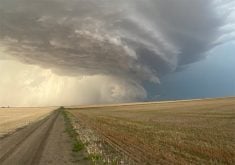The greater prairie chicken, an iconic bird of the North American grasslands, has officially disappeared from the western Canadian landscape.
The bird, once a common sight across the Canadian Prairies, was confirmed as extirpated late last year in a report prepared by the Committee on the Status of Endangered Wildlife in Canada (COSEWIC).
Extirpated means the bird no longer exists as a wild species in Canada.
Wild populations still exist in several U.S. states, but in Canada the species has been wiped out.
Read Also

Rented farmland jumps 3.4 million acres in Saskatchewan and Alberta
Farmland rented or leased in the two provinces went from 25.7 million acres in 2011 to 29.1 million in 2021, says Census of Agriculture data.
A million greater prairie chickens lived in Canada 100 years ago, primarily in southern and central Manitoba, Saskatchewan and Alberta.
The last unconfirmed sighting in Western Canada occurred in the early 1990s.
Marty Leonard, a COSEWIC bird specialist and professor of biology from Dalhousie University in Halifax, said many factors contributed to the prairie chicken’s demise.
The species was hunted heavily during some periods of the 20th century.
In the early 1900s, for example, the birds were often shot and shipped to markets in Eastern Canada.
In Manitoba, it was not uncommon for hunters to bag 60 and 150 birds in a single day, the COSEWIC report said.
However, the most significant factor was loss of habitat caused by agriculture, urbanization and other human activity, Leonard said.
The greater prairie chicken is highly sensitive to habitat loss and its preferred habitat, tall prairie grassland, has been reduced to about one percent of its original extent.
Factors that contributed to loss of habitat included extensive cattle grazing, large scale conversion of native grassland to cropland, and drought in the 1930s.
Wildlife officials have celebrated recent conservation successes in Western Canada.
Last October, 34 black footed ferrets were released into the Grasslands National Park in southwestern Saskatchewan.
The reintroduction was a collaborative effort headed by Parks Canada and the Toronto Zoo, which conducted a captive breeding program.
The ferret disappeared from its Canadian range in the late 1930s and was thought to be extinct by the mid-1970s.
In the early 1980s, the world’s last known population of black footed ferrets was discovered in Wyoming.
Since then, an estimated 6,000 animals have been bred in captivity.
The swift fox, another species that was once listed as extirpated, has also been successfully reintroduced in its original range in the prairie grassland region.
The species was extirpated from Canada in the 1930s but reintroduction programs were initiated in Alberta and Saskatchewan in the 1980s.
The number of animals now living on the Canadian Prairies is estimated at 650.















